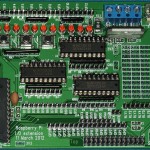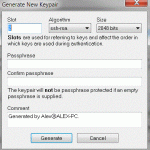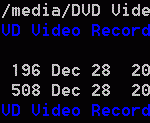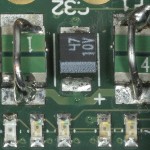This is a video of the Gertboard being put through its paces in the Darlington array relay switching tests. There is a Darlington array on the Gertboard that can drive up to six relays. Each can switch 50V and 0.5A. This video shows the program Gert provided to test this functionality (and train us how to use them too). On the video I talk about relays. In fact I mean Darlington array open collector relay drivers. My bad. ;)

I was setting up my Gertboard this morning to shoot some video and noticed that when I put my hand near it, some of the LEDs come on. Further investigation revealed that the Gertboard was acting as a proximity sensor. I thought that was pretty cool. Have a look and see. Does yours do this too or have I made it wrong? ;) Subsequently it was discovered that this is due to lack of pullup resistors on the self-assembly kit. The V2 assembled Gertboard launched in Jan 2013 has pullups, which is why the leds […more…]
Now I’ve got my Gertboard assembled, I thought I’d run some of the programs Gert supplied for testing and learning. First up LEDs. Delighted to say it worked a treat, so i thought I’d bring you a world premiere of the first blogged video of a Gertboard (sold to the public) in action. LEDs, camera, action… …and cut. Short and sweet. In case you’re wondering, I didn’t have enough jumpers and straps to make use of the last two LEDs on the board. I’ll be putting the rest of the board through its paces soon.

Just finished soldering the Gertboard together. Tested the voltage and it came in at 3.34V, which is within tolerance of the target 3.3V. So, next up will be to make it do something, but I thought you should all see it now it’s done. ;) You can click any of these shots to get the full sized version. No comments about RN7 ;) I’ll stick up some assembly shots in a little bit. In the meantime, here’s the thread where people are talking about their Gertboard Assemblies. http://www.raspberrypi.org/phpBB3/viewtopic.php?f=42&t=17987

Not much to say about this really. I found out that Tandy had these in stock so I ordered one on Tuesday evening, and it turned up this morning. Here’s a shot of the whole kit, including, board, ribbon cable, sheet of contents and the components packed in assembly order, heat-sealed in a plastic sleeve. Good idea that! :) Looks nice. Well done Tandy. I’ll get it built when I find a slot of time. :) According to a post in the Raspberry Pi forums, Tandy has bought the boards from Farnell and made up […more…]
Last week I published a blog and video of watching a DVD in Raspbian using omxplayer. At that time, as far as I could make out, nobody had managed to watch a commercial encrypted DVD, with the DVD drive attached to the Pi, but I figured it was only a matter of time. I ended that blog with… There is a way to watch encrypted DVDs in linux, but I haven’t sorted it out on my Pi yet. Hopefully a future video will detail that process. Well, I tried a few different things but was […more…]

If you want or need to be able to access and control your Raspberry Pi from outside your local area network (LAN), it’s a very good idea to disable password logins. This prevents hackers from being able to use/guess your password. In order to do this, we need to set up a public/private key pair and enable it for ssh login. This will make it almost impossible for a hacker to get into your Pi via ssh. The flip-side of that is the minor inconvenience of having to install your private key on any machine […more…]

In the last week in August (2012), the Raspberry Pi Foundation started selling MPEG2 codec licenses for the Pi. Basically without this you can’t do anything worthwhile with MPEG2 – the DVD file format. Although it’s an old codec, a lot of people have media libraries with MPEG2 files in, and some TV is still broadcast in MPEG2. You can use this license code to unlock the hardware decode functionality (for MPEG2) of the Pi’s GPU (Graphics Processing Unit). The Pi’s GPU is 95% of the main chip. It’s a real powerhouse for its size. […more…]

I’d heard of the “sticky key” issue on the Raspberry Pi. I’d even experienced it fleetingly once or twice, early on with Debian Squeeze. It seemed to disappear with the Wheezy beta release. And then I went headless – without a screen – doing everything by ssh for seven weeks while away from base. During that time, we got onto Raspbian Wheezy – the hard float release. Playing around with that, headless, over the summer, using the Edimax EW-7811Un wifi dongle was great. Then it was time to head home. One of the first things […more…]

Using two Pis at once I recently started using two Raspberry Pi’s on the same network. On top of that, I had a nicely developed and updated image of Raspbian, so I made an exact copy of the SD card for Pi #2. (see: how to backup an SD card image here | how to write an SD card here). But there were issues, and it took me some time to figure out why Pi #2 was crashing. Pi #1 (RS) is the one I’ve used since May. Pi #2 (Farnell) arrived a week later […more…]